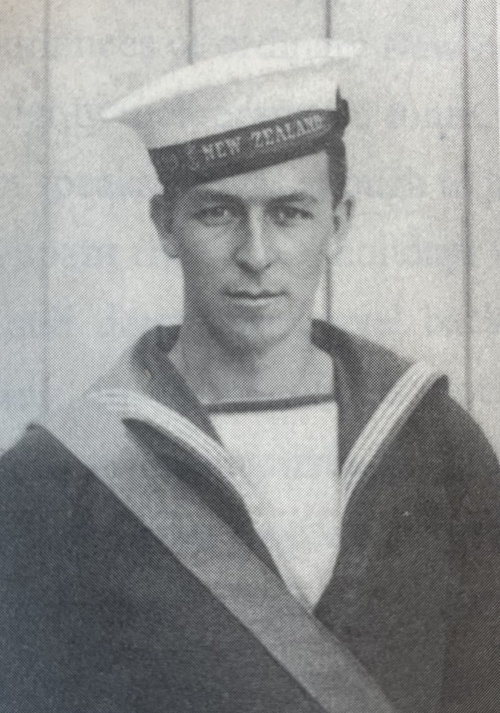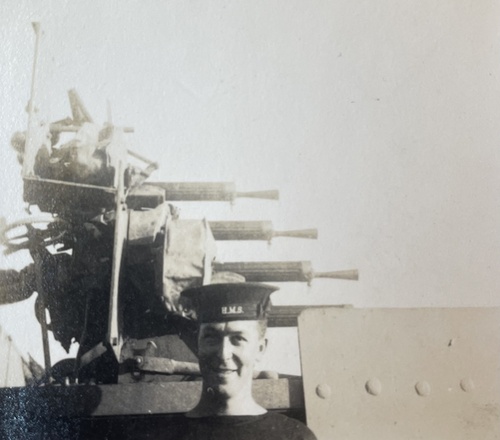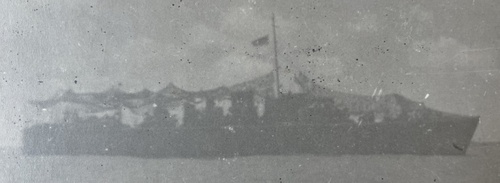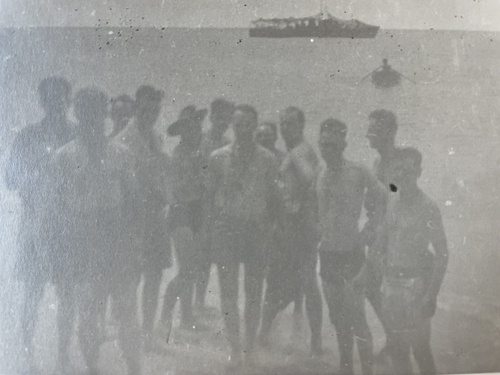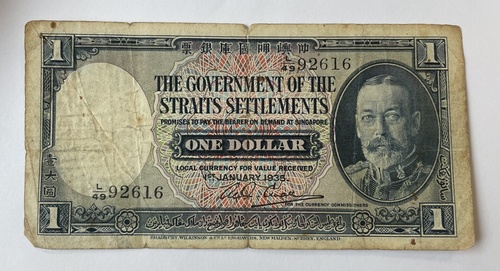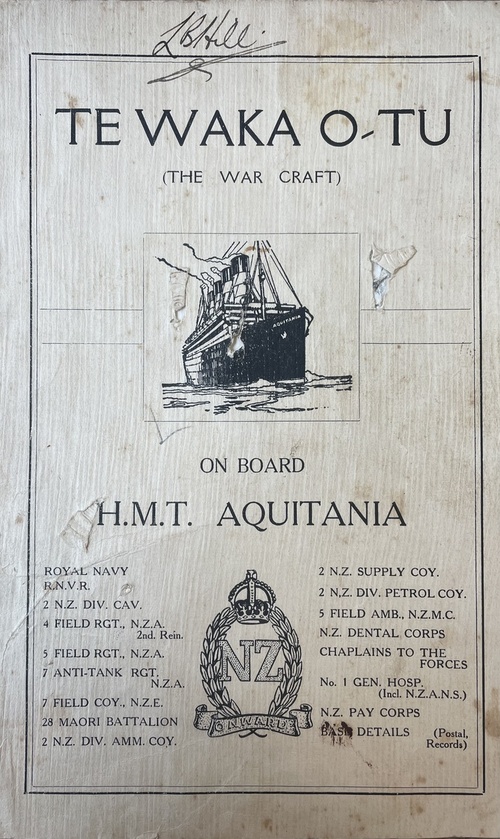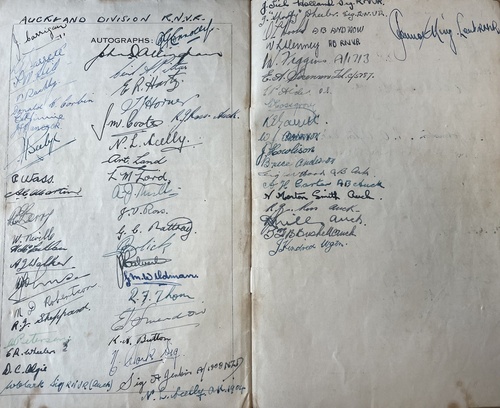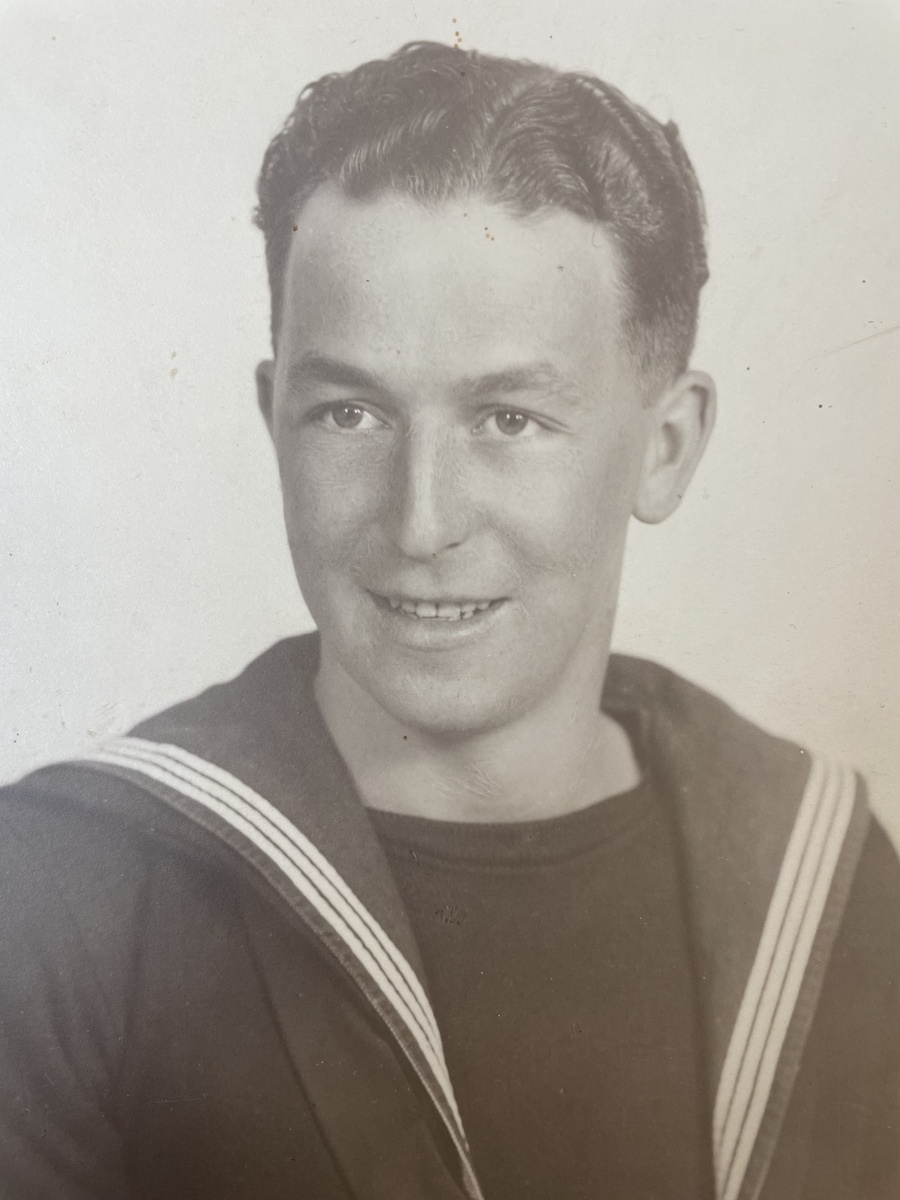Auction: 24003 - Orders, Decorations and Medals
Lot: 156
(x) Sold by Order of a Direct Descendant - to benefit a Prize for enrolment in the Royal New Zealand Navy
The rare 1942 'Escape from Singapore' D.S.M. group of seven awarded to Able Seaman L. B. Hill, Royal New Zealand Naval Volunteer Reserve
Hill sailed from Singapore aboard ML-310 on 13 February 1942, their passengers included various important Senior Officers, no less than Rear-Admiral Spooner and Air Vice Marshal Pulford in an attempt to make Java; they ran into an overwhelming Japanese force who engaged and ran them ashore at Tjibea Island
Together with Lieutenant Bull - a fellow member of the New Zealand 'Wavy Navy' - and another rating, Hill and his comrades took to a native prahu and made their run to Merak, a dangerous crossing which took a week through enemy lines to report the grisly fate which befell their important party - so fine was their work that Winston Churchill himself wrote of their mission
Distinguished Service Medal, G.VI.R., swivel suspension (A.1888 L, B. Hill. A,B. R.N.Z.N.V.R.), with its case of issue; 1939-45 Star; Atlantic Star; Pacific Star, clasp, Burma; Defence and War Medals 1939-45; New Zealand War Service Medal 1939-45, good very fine (7)
The proceeds from the sale of this Lot will go to the establishment of the Able Seaman Hill Prize at Otahuhu College, Auckland, to reward those who enrol into Royal New Zealand Navy.
D.S.M. London Gazette 2 November 1942 & New Zealand Gazette 16 March 1944. The original citation stated:
'For bravery in the Far East. On 13 February 1942, His Majesty's Minelayer ML310 left Singapore, having as passengers a party of Staff Officers and other ranks and ratings. The ship was intercepted by superior Japanese forces and it was decided to beach the ship on Tjibea Island and land the Staff party while the enemy was behind Joe Island. An enemy destroyer then came up, interrogated the Commanding Officer, wrecked the machinery and then ordered the crew on shore, as their ship was too full for prisoners.
The presence of the Staff party was unsuspected. A native prahu was then made seaworthy, and Lieutenant Bull, Leading Seaman Brough and Able Seaman Hill sailed it on a voyage of seven days to Merak, where arrangements were made to send help for the Staff party.'
Leonard Bruce Hill was born at Auckland, New Zealand on 22 October 1910 and was educated at Otahuhu College, Auckland. Perhaps the best biography of his remarkable life and times is offered by the Torpedo Bay Navy Museum:
'Leonard Hill, a nineteen year old who was living in Auckland when he volunteered for service with the Royal New Zealand Volunteer Reserve in August 1939. He was accepted for naval service under the Scheme B recruitment programme. This scheme sent New Zealand volunteers to the United Kingdom where they would be trained by the Royal Navy and if successful, given a temporary commission as an officer. The volunteer would have to spend time serving as a rating as part of their training. He was mobilised on 11 March 1940.
In May 1940 Leonard Hill sailed to the United Kingdom with a party of Scheme B recruits for training along with the Second Echelon of the 2NZEF. Upon arrival in the United Kingdom the New Zealanders where split up into divisions and sent to the three main Royal Navy bases at Chatham, Devonport, and Portsmouth. Hill was posted to Victory, the Royal Navy shore establishment located at Portsmouth. This base acted as the reception centre for from New Zealand recruits. Upon arrival the men were given a cold pie, prunes and custard for a meal. The training programme consisted of seamanship, physical exercises and sports. Hill remained there in training until he was transferred to Drake, the barracks and base at Devonport in August 1940. At Drake he was posted to the anti-aircraft ship Alynbank. She one of a number of merchant ships taken over by the Royal Navy and converted to anti-aircraft platforms to protect coastal convoys. In July 1941 he was posted to the shore establishment St Christopher at Fort William which was the training establishment for the Coastal Forces. It was here that he would have been trained to serve in motor launches. He was then posted to the shore establishment Attack, another Coastal Forces base located at Portland. It is understood that while at this shore establishment he joined a contingent of personnel to be assigned to motor launches based in Singapore.
In November 1941 he was posted to Sultan, the Royal Navy’s major naval base in the Far East located in Singapore. It had been commissioned in January 1940 and was the HQ for the Commodore-in-Chief of Singapore. Hill was assigned to the Flotilla of motor launches that were based at Sultan. He was serving in Sultan when war in the Pacific broke out in December 1941. As events were to prove, Malaya and Singapore were not adequately defended and were overcome more quickly than even that Japanese had planned for. This was due in great part to the British government’s parsimony towards defence spending in the interwar period. Force Z consisting of the battleships Prince of Wales & Repulse were supposed to be the core of Singapore’s naval defence but were sunk due to the singular lack of air cover and the effective Japanese naval aviation force. Plans made in the period before December 1941 assumed that a relief force would arrive in Singapore 90 days after any Japanese attack and before the defences could be overcome. Such confidence sowed the seeds of destruction for the Allied forces in Singapore in February 1942.
The Fall of Singapore
Even before the Japanese naval aircraft had attacked the United States Navy at Pearl Harbour elements of the Japanese Army were already landing on the Malayan coast. In less than seventy days Malaya was overrun and the Allied forces destroyed, captured, or pushed back to Singapore. From the beginning of January 1942 the Japanese navy closed access to the base through the Malacca Straits forcing convoys to approach Singapore through the Sunda Straits which were vulnerable to air attacks. Despite the risk, and what in hindsight was a futile gesture, over 45,000 men and a large amount of material was safely shipped to Singapore in a six week period even as the defences were being pushed back.
Rear-Admiral Spooner was tasked with the naval defence of Malaya and supporting the Allied army. The Fleet available to him consisted of ‘...converted yachts and harbour craft, private motor boats, and other similar vessels.’ Apart from the Japanese naval threat, his scratch force had to suffer under the air superiority the Japanese air forces and this prevented naval operations by day. For example, six fast Eureka boats that had been sent to Singapore in December were all sunk by February. Naval operations were restricted to small coastal craft including motor launches venturing from Singapore at night along the Malayan coast to try and assist the Allied defenders. Hill was serving on the launches during these efforts. Elements of the Japanese Army arrived at the causeway between Singapore and Malaya on 1 February and began shelling the island from the 2nd. On the same day, Sultan was abandoned. On 3 February Japanese aircraft were attacking with impunity the shipping in the harbour and the approaches to Singapore.
Japan was able to achieve a significant naval victory with only a portion of its fleet. The main Japanese naval fleet including their strike carriers was not deployed in support of the attacks on Malaya and Singapore, rather it was the Southern Force under the command of Vice-Admiral Kondo that destroyed the Allied naval forces and secured the valuable oil supplies and ports.
Singapore held out until 15 February 1942 when it surrendered on the same day the Allied High Command established a new HQ in Batavia. The Japanese fleet roamed at will in the waters off Indonesia and Malaya further strengthening their position with the defeat of the Allied naval force at the Battle of the Java Sea on 27 February. By this time Japanese forces had already landed in Java and engaged the Allied forces there including those who had escaped capture in Singapore. Java surrendered on 9 March 1942. The surrender of Java concluded a four month period of chaos and constant retreat for the Allied forces and seemingly unstoppable advances by the Japanese navy and army. The British and American navies could not check the Japanese forces due to insufficient naval units in the theatre or the time lag before naval units could be deployed in the Pacific.
The Evacuation of Singapore
The Australian Official History of the Medical Services notes that by the beginning of February as the Japanese attacks intensified ‘...[there] was a rising incidence of exhaustion states and neuroses, including some probably self-inflicted wounds.’ It is against this background of moral, organisational, and physical collapse that we can view Hill’s actions. The Japanese forces landed on Singapore on 8 February and occupied Sultan on the 11th. The base was supposed to be destroyed and denied to the enemy for use for several years. The reason why this plan approved by the Admiralty was never put into effect has never been discovered due to the death of Rear-Admiral Spooner who was authorised to put the plan into effect.
Three days after the Japanese landed on the island, all ships were ordered to evacuate Singapore and to make for the nearest Allied controlled ports. On 10 February 3,000 Airforce personnel were ordered to be evacuated from the island and thirteen merchant ships full of service personnel left Singapore on the night of the 11th. Spooner also ordered all naval personnel to be evacuated on night of 11 February. Two days before the official surrender was to go into force a plan was put into action to evacuate key personnel to Batavia. Japanese aircraft were continuously raiding the naval base in order to sink as many vessels as possible causing a large number of casualties. Hill was fortunate not to be amongst those injured or killed by the bombing and shelling. The final evacuation was inexplicably delayed until the night of 13-14 February.
Ships that left on 11-12 February were the last to successfully reach safety but suffered damage and casualties from Japanese aircraft attacks. From 12-15 February there was a stream of vessels that left Singapore trying to reach Sumatra. Japanese naval vessels relentlessly attacked these vessels. Survivors who managed to get ashore on the various islands died of starvation or disease, or were killed by Japanese forces. Only a handful of survivors were taken as POWs and returned to Singapore.
Escape from Singapore
On 13 February, the Rear Admiral Spooner’s Malaya Command authorised the use of motor launches and any sea-going craft that could be found to move a unit of 1,000 personnel from Singapore to Java. This unit consisted of officers and specialists from the Army, RAF, and Royal Navy. This party was to reinforce the Allied command headquarters in Java and would assist in a counter-attack there against Japanese forces.
That night, as part of the evacuation plan ML310, under the command of Lieutenant H. J. Bull RNZNVR embarked from Singapore with Rear Admiral Malaya E. J. Spooner, and Air Vice Marshall Pulford, Air Officer Commanding Far East accompanied by five staff officers and 26 Navy ratings (including Hill) and Army other ranks. Pulford's parting words to General Percival, who would surrender Singapore two days later, were ‘...I suppose you and I will be blamed for this, but God knows we’ve done our best with what we’ve been given.'
This was the last organised sailing from Singapore. Sadly the Allied command in Java was signalling Singapore that a Japanese fleet was waiting for any vessels leaving Singapore but the message was never given to the naval planners as the signal coders had already been evacuated. About seventeen small craft left along with ML310.The New Zealander Able Seaman Tim Hill, was serving in ML311. Because of their surnames and rates, both men’s history has been mixed up in various sources. ML311 was sunk and Tim Hill was rescued by the Japanese and survived Japanese captivity including working on the Burma Railway and was repatriated to New Zealand in 1945.
However the flotilla of between 40-50 (exact numbers are uncertain) vessels that left on 13 February was attacked by Japanese naval forces consisting of two cruisers, an aircraft carrier, and three destroyers. Nearly all vessels in this flotilla that left Singapore were sunk were sunk by Japanese vessels or aircraft between 14 and 16 February. This was a time when anything that could float was been put to use to evacuate civilians and military personnel a large of which ended up being killed or captured. Japanese radio had broadcast that ‘there will be no Dunkirk at Singapore.’ This was at a time when the Japanese forces were murdering small groups of POWs as they advanced through Java and the surrounding islands.
Spooner ordered that the launch depart at night and only sail in the darkness. Unfortunately as the launch departed Singapore it ran onto a sandbank injuring one of the crew. During the day it would lay up close to the shore. On the 14 February ML310 avoided being bombed by Japanese aircraft. For two days the party managed to avoid contact with Japanese surface vessels. On the afternoon of 15 February when nearing the Banka Strait the motor launch was intercepted by a Japanese destroyer. Some accounts state that the destroyer chased ML310 and sunk it off Tjibea Island, a “malarial island in the Tuju group, 48km north of Banka Island.” Other accounts of this event state that Lieutenant Bull ran ML310 ashore on Tjebia Island in escaping from the Japanese destroyer.
What is known is that the party reached Tjibea Island with no food, medical supplies, or means of reaching friendly forces. Quite soon after arrival plans were made to send a party to seek rescue for those stranded on Tjibea. Leonard Hill was selected to go on this mission. At this moment, it might be worthwhile to touch on another Kiwi who played his part - albeit a sinister one - in the Battle of Singapore. Patrick Stanley Vaughan Heenan was born at Reefton, South Island and served in the Indian Army. By the outbreak of the Second World War, he was attached to the Indian Army Air Liaison Unit at Alor Star. During the opening shots of the Battle of Malaya, he was caught spying for the Japanese and arrested. It had come at a huge cost however, for the loss of materiel and life as a result of his trechery was vast. It was said that having been arrested, Heenan mocked his guards saying that he would seen be free when the Japanese arrived. Hill was awoken having landed on the island, as recalled in Close to the Wind:
'The Air Vice Marshall, Conway Pulford, was talking to Ernest Spooner. His vehemence was striking.
'Patrick Heenan got what he deserved. He was a flash Harry, lots of money and plenty of women. He's been a problem in every unit he ever served in. We had our suspicions. Finding his radio removed all doubt. He must have been warning the Japs when our aircraft were refuelling, at their most vulnerable.'
The Admiral said something about a trial, and again the Air Vice Marshall replied, angrily this time.
'He was lucky he got a trial at all, the traitorous bastard! He was responsibly for the destruction of most of my planes. Not to mention the loss of my Pilots.'
The Admiral then said something Len could not quite hear.
'It was the only option. Neither Percival nor I were inclined to leave him behind alive. The Japs would have made a hero of him.'
'I'm glad it wasn't me, Con. Damned difficult situation.'
Heenan is understood to have been taunting his guards for days after his trial. As the Fall of Singapore became inevitable, cards were cut and a Sergeant is understood to have executed him on Keppel Harbour. Regarding those who were lost, it included aircraft and men of No. 62 Squadron, who were led by the gallant Squadron Leader Arthur Scarf V.C. (Medals sold in these Rooms in April 2022).
Back to Hill's remarkable adventure, The Official History of the Royal New Zealand Navy states that:
'A native prahu [sic] was made seaworthy and in it Bull, with two ratings (one of them being Hill) and two natives, made a passage of seven days to Merak in Java where arrangements were made to send help to those on the island. Lieutenant Bull was awarded the DSC and Able Seaman Hill the DSM for courage and devotion to duty.
However, Barber in Sinister Twilight states that Bull and Hill ‘managed to cross to Sumatra in a native boat to surrender.’ This clearly did not happen as both Bull and Hill reached safety and returned to duty. The Australian Official History of the Royal Australian Navy records the arrival of the party stating ‘that morning [27 February] a prau flying the White Ensign was sighted, and proved to contain a British [sic] naval officer (Lieutenant Bull), two soldiers, and three natives.’ The history does not identify Hill but it can be presumed that he was misidentified as a soldier. The history goes on:
'They had sailed from the Tujeh [sic], of Seven Islands, twenty miles north of Banka; and reported that rear-Admiral Spooner and Air Vice-Marshall Pulford were with a party on one of the islands. They were among some hundreds of men, women and children in similar straits.
It is understood that the last six hours of the passage was made by rowing continuously.'
Upon arrival at Merak on 27 February, Lieutenant Bull was ordered to report to the Allied HQ at Batavia on what had happened to his vessel and the senior commanders aboard. The Australian Official History notes that ‘by this time Japanese control of the sea and air prevented any attempts at rescue being organised.’ The party left behind suffered for a lack of food and disease and it was in April 1942 that the survivors including Tim Hill reached Sumatra to surrender to Japanese forces. Sadly, if the fate of the party had been known when Bull first reached Merak, there could have been a rescued by sending the Dutch submarine K-14.
Those left behind remained on the island for two months. Eighteen of the party including Spooner and Pulford and two New Zealanders died of malaria or pneumonia. Pulford died in early March. Spooner is reported to have died on 15 April 1942. By this time the Japanese had surrounded Java and were in control of the Java Sea. Any Allied forces remaining on Java at this time were not able to evacuate and were captured. Those who remained alive were captured by Japanese forces. Reports of officers who were captured stated the Japanese landed on Tjebia Island in June 1942. No papers were found, including a report and diary of Spooner that was hidden on the island. The graves were located and marked after the end of the war.
Lieutenant Bull was awarded the DSC and Able Seaman Hill the DSM. Able Seaman Hill’s award was based on the report of Lieutenant Bull who made special mention of his untiring efforts and devotion to duty both during the action and later on the Island were exemplary.
Over forty New Zealand officers and ratings lost their lives in the fall of Hong Kong and Singapore. Exact numbers are impossible to determine due to the chaotic situation as the surrender approached but of the total casualties of 138,708 suffered by Allied forces in operations in Malaya, Singapore, and Java, 130,000 became prisoners of war. Leonard Hill was one of the few New Zealanders who managed to escape the chaos in February 1942 and avoid three years of horrendous captivity.
After his escape and return to friendly forces Hill returned to New Zealand in April 1942. He then spent the rest of 1942 undertaking training in anti-submarine warfare at the Naval Electrical School in Petone until October 1942. He then returned to Philomel and served there until the end of November. He was then posted to the Fairmile ML-403 under the command of Lieutenant Bull on 1 December 1942. He served with the Fairmile in New Zealand waters until 1944 when the Fairmiles were organised into two flotillas for deployment to the Solomons. He took ML-403 to the Solomons and served in theatre from April-July 1944 when he was returned to New Zealand until December. He then returned to the Solomons and served for a month in the shore establishment HMNZS Kahu located at Renard Sound. He was discharged from the RNZN on 28 October 1945. His is a story of courage, fortitude and survival against great odds in the best traditions of the Royal New Zealand Navy.'
Such was the regard in which the efforts of Hill and his comrades that Winston Churchill wrote in his piece entitled 'Struggle to Defence Singapore - Tragic fate which overtook 3000 Evacuees':
'...Their last voyage - On the 13th, the prepared scheme for evacuating to Java by sea some 3000 nominated individuals was put into effect. Those ordered to go included key men, technicians, surplus Staff Officers, nurses and others whose services would be of special value for the prosecution of the war. With them went Air Vice Marshal Pulford and Rear Admiral Spooner, who had commanded air and naval forces in the fortress.
It was their last voyage. A Japanese naval force escorting the expedition against Sumatra fell upon them. Of about 80 little ships of all kinds that set out from Singapore on this and the following day, almost all were lost or captured by the enemy.
It is only since the war that the fate of Pulford and Spooner has become known and we may here persue the story to its bitter ending. On February 15th, their vessel was attacked be enemy destroyers and driven ashore on a small island. They and about 45 other who had embarked with them, succeeded in landing without interference. One of their number, a young New Zealand Officer, then set off in a native boat, and after many adventures reached Batavia.'
Another cutting adds the personal detail:
'Another Aucklander in Escape - Mr Churchill's Story
A second Aucklander and a Scotsman were with Lieutenant-Commander Bull, referred to by Mr Winston Churchill as an un-identified New Zealander in his story of the evacuation of 3000 from Singapore. The Aucklander is Mr L. Hill, formerly an Able Seaman.'
What is more remarkable about his escape was the day after arriving in Java, Japanese forces mounted another attack forcing Hill and those with him to escape yet again finding passage on the vessel General Verspijk to Freemantle, Australia. Hill remained close with Bull, who was godfather to his son and died in 1999.
His son published Close to the Wind - A story of Escape and Survival out of the Ashes of Singapore 1942 in 2019, a signed copy accompanies the Lot.
Sold together with the following original archive comprising:
(i)
Dominion of New Zealand copy of Official Citation.
(ii)
Various original annotated photographs featuring Hill, including several having left Singapore.
(iii)
Government of the Straits Settlements, One Dollar Note, plucked from Singapore Harbour by Hill during the Evacuation.
(iv)
Te Waka O-Tu on board HMS Aquitania, May 1940, from the voyage to England from New Zealand, with various signatures of members of the RNZNVR.
(v)
Forwarding note for his Campaign Awards.
Subject to 5% tax on Hammer Price in addition to 20% VAT on Buyer’s Premium.
Sold for
£3,500
Starting price
£3500


